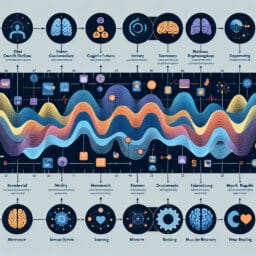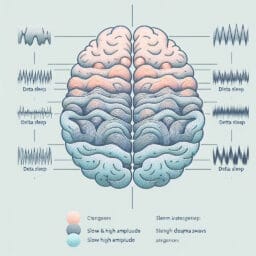
Understanding the Stages: The Definition of Non-REM Sleep
Table of Contents
- Introduction to Non-REM Sleep
- Understanding the Stages of Non-REM Sleep
- The Role of Non-REM Sleep in Health
- How to Improve Non-REM Sleep
- Conclusion: The Importance of Understanding Non-REM Sleep
- Frequently Asked Questions
Introduction to Non-REM Sleep
In the realm of sleep medicine, Non-Rapid Eye Movement sleep or Non-REM sleep holds significant importance as it constitutes a major portion of the human sleep cycle. Upon falling asleep, you typically enter NREM stage one, which is the lightest stage of your slumber. Brain activity slows down and heart rate along with blood pressure drops slightly. A surprising fact is that during this initial phase, sudden twitches known as hypnic jerks can occur.
As you transition into deeper stages of NREM sleep like slow-wave sleep or deep-sleep stage; your brain waves continue to slow down producing delta waves, body temperature reduces and eye movements cease. This period is crucial for memory consolidation including procedural memory and overall restorative functions of the body.
However, an imbalance in these stages due to factors that disrupt sleep can result in a higher risk of health issues such as immune system deficiencies and heart problems. Striking a balance between REM and Non-REM cycles plays an important role in maintaining quality sleep and overall health.
Optimizing bedtime routine to aid in falling asleep faster and ensuring total sleep time aligns with circadian rhythms are some ways to improve NREM stages. Understanding your personal NREM-REM cycle could be key to addressing potential sources of poor-quality slumber like various types of insomnia or other persistent sleep-related issues.
Understanding the Stages of Non-REM Sleep
Delving deeper into the stages of non-REM sleep, it becomes evident how each plays a vital role in maintaining our health. As we transition from wakefulness to slumber, stage one NREM sleep is initiated. This phase signifies the lightest stage of our sleep during which brain activity begins slowing down. Eye movements lessen, heart rate and blood pressure decrease slightly as your body prepares for rest. It’s during this initial phase where you’re most prone to be awoken, yet it serves an essential function by paving the way for subsequent stages of sleep.
Following this transition period is stage two NREM sleep – typically defined as light sleep. Brain waves continue to slow but are punctuated by brief surges known as ‘sleep spindles’. While often overlooked due to its ‘light’ moniker, this stage holds critical importance within our overall sleep cycle. It occupies nearly 50% of total adult sleep time and acts like a buffer zone preparing us for deep-sleep phases.
The final stage within the NREM realm is deep-sleep or slow-wave sleep – recognized scientifically by high amplitude delta waves on an NREM Sleep EEG recording. The significance of this deep-sleep stage cannot be overstated – it’s key in memory consolidation and cognitive restoration processes that rejuvenate us mentally for another day ahead.
To comprehend why spending time in these NREM stages matters so much, imagine depriving yourself of quality REM or Non-Rem cycles – what happens? The repercussions could range from impaired cognitive functions like concentration difficulties to experiencing perpetual fatigue despite seemingly getting ‘enough’ hours asleep at night.
Each successive non-rem — rem cycle plays its part in fortifying your immune system and regulating heart rate among other physiological processes necessary for wholesome health. Understanding these intricate facets enables better management of any potential disruptions that may arise within our circadian rhythms or common occurrences such as bedtime routine modifications impacting when you fall asleep.
| Stages of Non-REM Sleep | Description |
|---|---|
| Stage One NREM Sleep | This is the lightest sleep stage where brain activity slows down. Eye movements lessen and heart rate and blood pressure decrease as the body prepares for rest. This stage makes up the transition from wakefulness to sleep and is when you’re most prone to be awoken. |
| Stage Two NREM Sleep | This stage, often referred to as ‘light sleep’, is characterized by slowing brain waves with brief surges known as ‘sleep spindles’. Despite its ‘light’ moniker, it’s critically important as it occupies nearly 50% of total adult sleep time and acts as a buffer zone preparing us for deep sleep phases. |
| Deep-Sleep or Slow-Wave Sleep (Final NREM Stage) | This is the deepest sleep stage, scientifically recognized by high amplitude delta waves on an NREM Sleep EEG recording. It plays a crucial role in memory consolidation and cognitive restoration processes, mentally rejuvenating us for the next day. |
| Repercussions of Sleep Deprivation | Depriving oneself of quality REM or Non-Rem sleep could lead to impaired cognitive functions like concentration difficulties and perpetual fatigue despite seemingly getting ‘enough’ sleep. |
| Importance of Non-REM — REM Cycles | Each successive non-rem — rem cycle plays a part in fortifying the immune system and regulating heart rate among other physiological processes necessary for wholesome health. Understanding these stages can help better manage potential disruptions within our circadian rhythms or modifications to bedtime routines. |
The Role of Non-REM Sleep in Health
Unraveling the complexities of Non-REM (NREM) sleep stages gives us a window into the world of sleep medicine and its deep-rooted connection to our health. The stage NREM sleep is especially important as it encompasses light sleep, deep sleep, and everything in-between – each performing a unique function within the intricate symphony of our sleep cycle.
As you transition from wakefulness to slumber, your body first enters light sleep or stage one NREM sleep. Herein begins the fascinating journey – brain activity starts to slow down, eye movements lessen, and both heart rate and blood pressure decrease slightly as your system prepares for rest. This quiet lull before the storm of deeper stages is beneficial in maintaining healthy circadian rhythms.
Venturing further into this realm leads us to stage two NREM sleep – often misconstrued due to its ‘light’ moniker but holding critical importance for overall quality sleep. Brain waves continue their unhurried dance alongside brief surges known as ‘sleep spindles’. This phase acts like a buffer zone preparing your body for more profound restorative phases yet to come.
The magnum opus of any good night’s rest is reaching that coveted deep-sleep or slow-wave phase; scientifically distinguished by high amplitude delta waves on an NREM Sleep EEG recording. During this sacred period marked by little-to-zero eye movements and diminished body temperature, memory consolidation takes place strengthening procedural memory which impacts skills learning while cognitive restoration fortifies mental resilience readying you for another dynamic day ahead.
Overarching all these definitive aspects is the indomitable role non-rem — rem cycles play in bolstering immune system efficacy and ensuring heart rate regulation among other physiological processes necessary for sustenance. However, disruptions caused by persistent stressors that disrupt optimal balance can pose higher risks including chronic fatigue despite seemingly ample time spent asleep at night.
Nonetheless, understanding these nuances allows proactive steps towards staving off potential sleep disorders and promoting healthier sleep habits. Such knowledge is instrumental in fostering better quality of life and overall well-being – emphasizing the importance of NREM stages, falling asleep in sync with our circadian rhythm, and recognizing when to seek help for persistent sleep-related issues.
How to Improve Non-REM Sleep
The harmonious symphony of sleep is an intricate dance dominated by the essential rhythm of Non-REM (NREM) and REM stages. Expert studies in sleep medicine have underscored the importance of these NREM stages, revealing their surprising role not just in providing restful slumber but also fortifying our overall health. The first stage NREM sleep, often considered as lightest sleep, ushers us into a serene state where brain activity mellows down and physical indicators like heart rate and blood pressure subtly dip. This peaceful prelude gives way to stage two – defined by slowing brain waves peppered with ‘sleep spindles’, preparing us for deeper cycles yet to unveil.
Delving further into this realm leads to the deep-sleep stage or slow-wave sleep; identified by dominant delta waves on an NREM Sleep EEG recording. This crucial phase hosts memory consolidation processes that strengthen procedural memory which directly impacts skills learning. Moreover, it’s during this period that cognitive restoration occurs – reenergizing mental resilience for another day ahead.
Maintaining healthy circadian rhythms aids much-needed transition between these stages while ensuring optimal benefits from each cycle – be it reinforcing your immune system or regulating heart rate. However, disruptions caused by factors like stressors can upset this balance leading to higher risk issues including chronic fatigue even after time spent asleep at night seems adequate.
Falling asleep in line with our natural body clock is instrumental in experiencing quality sleep and avoiding potential sleep disorders. Having a consistent bedtime routine can help tune our body to align better with its circadian rhythm thereby improving both duration and quality of non-rem — rem cycles.
Diet and exercise too play pivotal roles here – balanced nutrition fosters healthier patterns whereas regular physical activity promotes quicker onset of deep-sleep stages thereby enhancing overall benefits derived from total sleep time. These insights amplify the understanding about intricacies involved within NREM stages indicating how their effective management has far reaching implications on our health and quality of life.
Conclusion: The Importance of Understanding Non-REM Sleep
Delving into the intricacies of Non-REM sleep, profound insights reveal that our night’s rest is not just a dormant phase but an orchestra of purposeful cycles. Each stage – light sleep, deep sleep and everything in between – plays an impactful role in fortifying our overall health. From initial slow down of brain activity to the dance of ‘sleep spindles’, we are led to the profound realms of slow-wave sleep marked by dominant delta waves for restorative memory consolidation. Tuning this delicate balance with careful bedtime routines can foster healthier circadian rhythms, aiding quality sleep and overall wellness. Awaken to new understanding about Non-REM — REM interplay, as it’s here lies key to combating potential sleep disorders and nurturing optimal mental resilience and immune system performance – all contributing to a more vibrant life rhythm.


